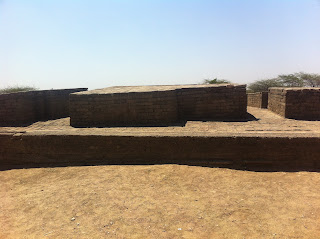Inside Lothal : The architecture
The small settlement of Lothal held for us the wonders and marvels of the past that no textbooks would ever have. The architectures that remained gave us an insight to what life would have been back in those days.
Dockyard
The first architectural remain we came across was the dockyard. It was supposed to be 2.5 meters deep and the walls were supposed to be 1.5 meters thick. Bricks were of a standardized ratio and were placed in such a manner that they allowed interlocking. Dr. S. R. Rao firmly believed that this structure was a dockyard and not a reservoir as some historians seem to suggest.
He argued that there was an evidence of marine life and shells being found in the dock area which won’t be otherwise found in a reservoir. In all reservoirs that have been found at other Harappan sites, there is a fleet of stairs leading to the bottom of the tank, whereas no such stairs have been found at the site in Lothal and the dimensions are too big to be considered a reservoir for a meager population of about 2000 people. The dock was connected with the sewer and drainage pipes which would not be in the case of a reservoir.
Wells
Wells were an absolute necessity for the harappans, living especially in areas such as Lothal and Dholavira. They were made out of bricks that were trapezium shaped which prevented the falling down of the wells. The Mesopotamians on the other hand, preferred a cylindrical structure to wells, that even if they fall apart they won’t really mind rebuilding the wells.
Harrapan wells were used in continuity even after their decline for almost 700 years.
Citadel
The town as we discussed earlier was divided into the lower town and the acropolis (citadel). The citadel is probably the place where the head of authority stayed. It consisted of structures like the warehouse and the “royal building” with 12 bathrooms built in a line, which were probably of great religious significance back then.
The warehouse was the place where goods from far and wide, when they arrived were sent. There the transactions would probably have taken place.
Drainage system
The Harappans gave us many gifts and one of them was the importance of drains. They planned their cities in such a way that the drains were laid out first and then the houses and streets were built over them. They were great engineers and architects and their technologies and township planning have stood against the test of time. The streets were made in a grid like pattern cutting at ninety degrees. The town planning strategies and the way in which towns of those times have been laid and planned out, baffles historians even today.




Comments
Post a Comment